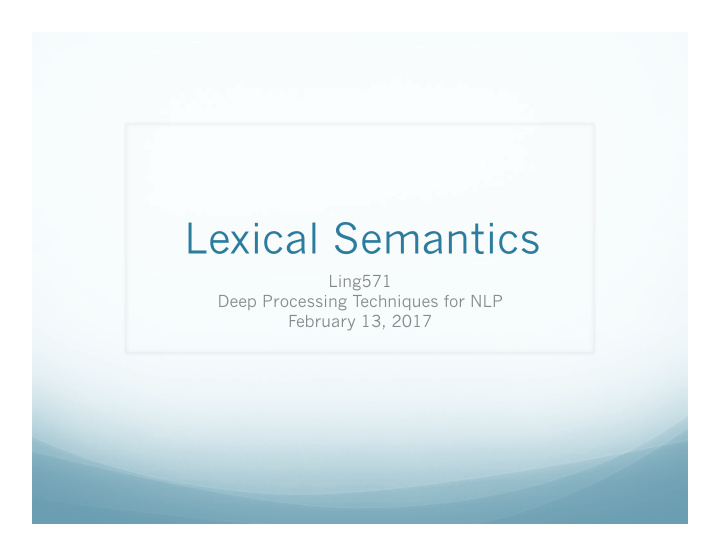



Lexical Semantics Ling571 Deep Processing Techniques for NLP February 13, 2017
Roadmap Lexical semantics Motivation & definitions Word senses Tasks: Word sense disambiguation Word sense similarity Distributional similarity
What is a plant? There are more kinds of plants and animals in the rainforests than anywhere else on Earth. Over half of the millions of known species of plants and animals live in the rainforest. Many are found nowhere else. There are even plant s and animals in the rainforest that we have not yet discovered. The Paulus company was founded in 1938. Since those days the product range has been the subject of constant expansions and is brought up continuously to correspond with the state of the art. We ’ re engineering, manufacturing, and commissioning world-wide ready-to-run plants packed with our comprehensive know-how.
Lexical Semantics So far, word meanings discrete Constants, predicates, functions Focus on word meanings: Relations of meaning among words Similarities & differences of meaning in sim context Internal meaning structure of words Basic internal units combine for meaning
Terminology Lexeme : Form: Orthographic/phonological + meaning Represented by lemma Lemma : citation form; infinitive in inflection Sing: sing, sings, sang, sung,… Lexicon : finite list of lexemes
Sources of Confusion Homonymy: Words have same form but different meanings Generally same POS, but unrelated meaning E.g. bank (side of river) vs bank (financial institution) bank 1 vs bank 2 Homophones: same phonology, diff ’ t orthographic form E.g. two, to, too Homographs: Same orthography, diff ’ t phonology Why do we care? Problem for applications: TTS, ASR transcription, IR
Sources of Confusion II Polysemy Multiple RELATED senses E.g. bank: money, organ, blood,… Big issue in lexicography # of senses, relations among senses, differentiation E.g. serve breakfast, serve Philadelphia, serve time
Relations between Senses Synonymy: (near) identical meaning Substitutability Maintains propositional meaning Issues: Polysemy – same as some sense Shades of meaning – other associations: Price/fare; big/large; water H 2 O Collocational constraints: e.g. babbling brook Register: social factors: e.g. politeness, formality
Relations between Senses Antonyms: Opposition Typically ends of a scale Fast/slow; big/little Can be hard to distinguish automatically from syns Hyponomy: Isa relations: More General (hypernym) vs more specific (hyponym) E.g. dog/golden retriever; fruit/mango; Organize as ontology/taxonomy
Word Sense Disambiguation Application of lexical semantics Goal: Given a word in context, identify the appropriate sense E.g. plants and animals in the rainforest Crucial for real syntactic & semantic analysis Correct sense can determine Available syntactic structure Available thematic roles, correct meaning,..
Robust Disambiguation More to semantics than P-A structure Select sense where predicates underconstrain Learning approaches Supervised, Bootstrapped, Unsupervised Knowledge-based approaches Dictionaries, Taxonomies Contexts for sense selection
There are more kinds of plants and animals in the rainforests than anywhere else on Earth. Over half of the millions of known species of plants and animals live in the rainforest. Many are found nowhere else. There are even plants and animals in the rainforest that we have not yet discovered. Biological Example The Paulus company was founded in 1938. Since those days the product range has been the subject of constant expansions and is brought up continuously to correspond with the state of the art. We ’ re engineering, manufacturing and commissioning world- wide ready-to-run plants packed with our comprehensive know- how. Our Product Range includes pneumatic conveying systems for carbon, carbide, sand, lime and many others. We use reagent injection in molten metal for the… Industrial Example Label the First Use of “ Plant ”
Disambiguation Features Key: What are the features? Part of speech Of word and neighbors Morphologically simplified form Words in neighborhood Question: How big a neighborhood? Is there a single optimal size? Why? (Possibly shallow) Syntactic analysis E.g. predicate-argument relations, modification, phrases Collocation vs co-occurrence features Collocation: words in specific relation: p-a, 1 word +/- Co-occurrence: bag of words.. Train classifiers to predict senses w/these features
WSD Evaluation Ideally, end-to-end evaluation with WSD component Demonstrate real impact of technique in system Difficult, expensive, still application specific Typically, intrinsic, sense-based Accuracy, precision, recall SENSEVAL/SEMEVAL: all words, lexical sample Baseline: Most frequent sense Topline: Human inter-rater agreement: 75-80% fine; 90% coarse
Word Similarity Synonymy: True propositional substitutability is rare, slippery Word similarity (semantic distance): Looser notion, more flexible Appropriate to applications: IR, summarization, MT , essay scoring Don’t need binary +/- synonym decision Want terms/documents that have high similarity Differ from relatedness Approaches: Distributional Thesaurus-based
Distributional Similarity Unsupervised approach: Clustering, WSD, automatic thesaurus enrichment Insight: “You shall know a word by the company it keeps!” (Firth, 1957) A bottle of tezguino is on the table. Everybody likes tezguino . Tezguino makes you drunk. We make tezguino from corn. Tezguino: corn-based, alcoholic beverage
Distributional Similarity Represent ‘company’ of word such that similar words will have similar representations ‘Company’ = context Word represented by context feature vector Many alternatives for vector Initial representation: ‘Bag of words’ binary feature vector Feature vector length N, where N is size of vocabulary f i = 1 if word i within window of w , 0 o.w.
Binary Feature Vector
Distributional Similarity Questions What is the right neighborhood? What is the context? How should we weight the features? How can we compute similarity between vectors?
Recommend
More recommend